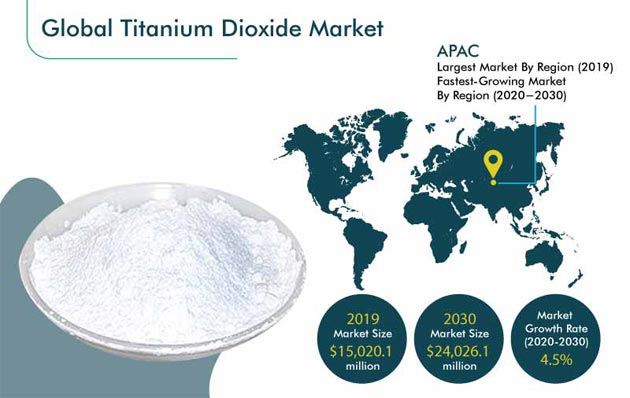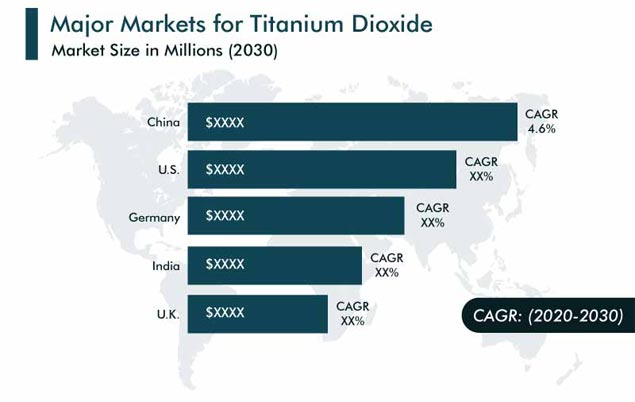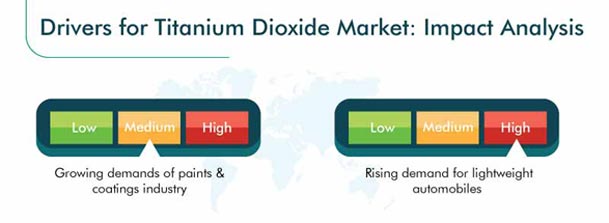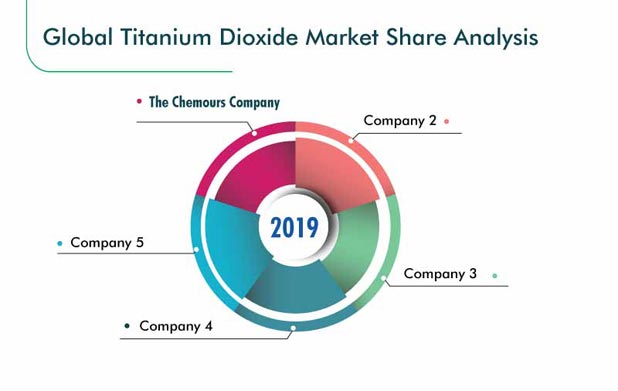Report Code: 10880 | Available Format: PDF | Pages: 176
Titanium dioxide Market Research Report: By Process (Sulphate, Chloride), Application (Paints & Coatings, Plastics, Paper, Inks) - Global Industry Analysis and Demand Forecast to 2030
- Report Code: 10880
- Available Format: PDF
- Pages: 176
- Report Description
- Table of Contents
- Market Segmentation
- Request Free Sample
Market Outlook
The market for titanium dioxide is predicted to grow at a CAGR of 4.5% from 2020 to 2030. Paints & Coatings application category dominating market.
The COVID-19 pandemic has negatively affected almost all industries, including automobile and construction, across the globe. As these are the major end users of titanium-dioxide-containing pigments and other products, the slowdown in their growth is hampering the progress of the market. Moreover, because of the imposition of strict restrictions on logistics and transportation activities and the shutting down of factories, on account of the announcement of lockdowns, the construction and automobile industries are experiencing stagnation, which is, in turn, negatively impacting the sales of titanium dioxide and the end products containing this chemical.

Sulphate Holding Larger Share in Titanium Dioxide Market
Between the two major titanium dioxide production processes, namely chloride and sulphate, the sulphate process was used more in 2019. The main factor responsible for the expansion of this category in the titanium dioxide market is the fact that unlike the chloride process, which can only extract titanium dioxide from rutile ores, the sulphate process makes the extraction of the compound from all ores, including rutile, ilmenite, and titania slag, possible.
Additionally, the sulphate process uses a mature and simpler technology for extracting the product, and the devices used are highly resistant to corrosion and easy to use. Because of these advantages, the sulphate category held the larger market share in 2019, and this trend is predicted to continue in the coming years.
Paints & Coatings Application Category Dominating Market
The paints & coatings category is currently generating the highest revenue in the application segment of the market for titanium dioxide, and it is predicted to exhibit the fastest growth in the forthcoming years. This will be because of the growing consumption of paints and coatings in various architectural applications, as per the Titanium Dioxide Manufacturers Association in 2019. The mushrooming requirement for the compound in paints and coatings is credited to its high refractive index, inert and non-toxic nature (in the external environment), and high ultraviolet (UV) ray absorbing capability.
Furthermore, the growth of the paints & coatings category in the titanium dioxide market is being caused by the extensive usage of the compound in the paints and coatings applied on the exterior of buildings in tropical and warm climates, due to the ability of the compound to impart light reflecting qualities and whiteness. This can lead to huge energy savings, as the light reflecting qualities imparted by the compound massively reduce the requirement for air conditioning.
Asia-Pacific (APAC) — Largest and Fastest-Growing Region
Due to the establishment of various production facilities and presence of a booming construction industry, because of the surging population and increasing urbanization rate, the requirement for paints and coatings is soaring in the APAC region. This is, in turn, driving the expansion of the market for titanium dioxide in APAC.
In this regard, a major factor fueling the demand for the compound is the surging number of infrastructure development projects in regional countries, because of which the construction of apartments, hotels, offices, civic infrastructure, and retail centers is picking up. This is creating lucrative growth opportunities for the paint & coating manufacturing companies in the region. As the compound is a major ingredient of paints and coatings because of its high UV resistance, opacity, and ultra-white color, the soaring requirement for paints and coatings is propelling the titanium dioxide market expansion in the APAC region.
Furthermore, the extensive usage of the compound in several other application areas, such as cosmetics, plastics, paper, and inks, is creating immense opportunities for titanium dioxide producers. China dominated the APAC market in the past due to the huge domestic production of titania on account of the huge requirement for paints and coatings in the country.

Growing Popularity of Self-Cleaning Technologies Is Major Market Trend
One of the major trends presently being observed in the titanium dioxide industry is the growing preference for self-cleaning technologies over conventional cleaning technologies, particularly for windows and smartphones. The presence of titanium dioxide nanomaterials in these self-cleaning technologies provides resistance to dirt by triggering a chemical reaction that breaks down the dirt particles. Furthermore, an electrochemical reaction is triggered by the compound’s self-cleaning ability, in its photocatalyst form, which subsequently causes the activation of the compound, thereby leading to the generation of free radicals. These free radicals have the ability to inactivate fungi, viruses, and bacteria and decompose pollutants, before dissipating.

Soaring Demand for Paints & Coatings Fueling Market Boom
The soaring requirement for paints and coatings across the globe is one of the major growth drivers for the titanium dioxide market. This is because titanium dioxide is a key ingredient of paint and coating pigments. According to the World Paint & Coatings Industry Association, the worth of the worldwide sales of paints and coatings was $172.8 billion in 2019. The high sales of paints and coatings are attributed to the growth in the automotive industry, high household expenditure, rapid improvements in economic conditions, rise in the urban population, and huge construction expenditure in several countries.
Furthermore, the compound’s low cost, low haze, and ability to easily blend with various kinds of solvents, such as water and alcohol, make it suitable for use in paints and coatings.
Increasing Adoption of Lightweight Vehicles another Major Market Driver
The other major factor driving the expansion of the market is the growing deployment of lightweight vehicles on account of the increasing concerns over automotive emissions, fuel efficiency, and carbon footprint. The ballooning usage of the compound in the coatings applied on the polycarbonate structures used in lightweight vehicles, due to the ability of the coatings to impart scratch resistance, durability, and stability to these structures, is fueling the compound’s consumption. The usage of polycarbonate plastics in place of traditional glass causes a 50% reduction in vehicle weight and improves the aesthetics of the vehicle, by replacing the seams. This is, in turn, propelling the expansion of the titanium dioxide market.
High Adoption of Lightweight Vehicles Drives Titanium Dioxide Market
Another prominent driver for this market is the rising adoption of lightweight vehicles, owing to the growing concerns related to automotive emissions, carbon footprints, and fuel efficiency. The increasing use of this compound for the coatings applied on polycarbonate structures, which are used in the manufacturing of lightweight automobiles, owing to the ability of the coatings to impart stability, scratch resistance, and durability to the polycarbonate structure, is propelling titanium dioxide consumption during the production of lightweight vehicles.
Furthermore, the replacement of traditional glass with polycarbonate plastics reduces the weight of the vehicle by 50% and improves the aesthetics by replacing the seams, which is driving the market for this compound across the world.
Mergers & Acquisitions Provide Competitive Edge to Market Players
The titanium dioxide market is consolidated in nature, owing to the presence of key players, namely The Chemours Company, Tronox Limited, Lomon Billions Group, NL Industries, Tayca Corporation, and Venator Materials PLC.
Owing to recent mergers and acquisitions, various players have entered the titanium dioxide market:
- In May 2020, Tronox Holdings announced that it has signed an agreement to acquire the TiZir Titanium and Iron (“TTI”) business from Eramet S.A., a publicly-traded French multinational mining and metallurgy company, for approximately $300 million. This strategic acquisition represents the next step of Tronox Holdings in the advancement of its vertical integration strategy, by providing Tronox with a larger titanium feedstock, to better fulfill its internal requirements. This, in turn, will help the company better serve its pigment customers, with a low-cost and secure supply of titania.
- In August 2019, The Chemours Company acquired Southern Ionics Minerals LLC, a mining, mineral exploration, and manufacturing company. Southern Ionics’s operations include the mining and processing of titanium and zirconium mineral sands. The nearly $25-million agreement is expected to double the company’s mineral sand processing capacity.
| Report Attribute | Details |
Historical Years |
2014-2019 |
Forecast Years |
2020-2030 |
Base Year (2019) Market Size |
$15,020.1 Million |
Forecast Period CAGR |
4.5% |
Report Coverage |
Market Trends, Revenue Estimation and Forecast, Segmentation Analysis, Regional and Country Breakdown, Company Share Analysis, Companies’ Strategic Developments, Product Benchmarking, Company Profiling |
Market Size by Segments |
Process, Application, Geography |
Market Size of Geographies |
U.S., Canada, Germany, U.K., Finland, Belgium, Italy, Netherlands, China, Japan, India, South Korea, Brazil, Mexico, Saudi Arabia, and South Africa |
Secondary Sources and References (Partial List) |
Abrafati Brazilian Coatings Manufacturers Association, American Coatings Association, Automobile Association of Southern India, Calgary Construction Association, European Automobile Manufacturers Association, Titanium Dioxide Manufacturers Association, National Paint & Coatings Association |
Explore more about this report - Request free sample
Some of the key market players in the titanium dioxide market include:
-
The Chemours Company
-
Tronox Incorporated
-
TAYCA CORPORATION
-
The Kerala Minerals & Metals Ltd.
-
PRECHEZA a.s.
-
Prakash Chemicals Pvt. Ltd.
-
Travancore Titanium Products Ltd.
-
CINKARNA, Metalurško-kemična Industrija Celje, d.d
-
Lomon Billions
-
Evonik Industries AG
-
Kilburn Chemicals Limited
-
Titanos Group
-
Grupa Azoty S.A.
-
Venator Materials PLC
-
Argex Titanium Inc.
-
Huntsman International LLC.
-
Hengxing Minerals Ltd.
-
China Northern Rare Earth Group High-Tech Co. Ltd.
-
Noval Industrial Group Co. Limited
-
Alchemy Heavy Metals Pvt. Ltd.
Titanium dioxide Market Size Breakdown by Segment
The titanium dioxide market report offers comprehensive market segmentation analysis along with market estimation for the period 2014–2030.
Based on Process
- Sulphate
- Chloride
Based on Application
- Paints & Coatings
- Plastics
- Paper
- Inks
Geographical Analysis
- North America
- U.S.
- Canada
- Europe
- Germany
- U.K.
- Finland
- Belgium
- Italy
- Netherlands
- Asia-Pacific (APAC)
- China
- Japan
- India
- South Korea
- Latin America (LATAM)
- Brazil
- Mexico
- Middle East and Africa (MEA)
- Saudi Arabia
- South Africa
Want a report tailored exactly to your business strategy?
Request CustomizationWant an insight-rich discussion with the report author?
Speak to AnalystOur dedication to providing the most-accurate market information has earned us verification by Dun & Bradstreet (D&B). We strive for quality checking of the highest level to enable data-driven decision making for you
Our insights into the minutest levels of the markets, including the latest trends and competitive landscape, give you all the answers you need to take your business to new heights
With 24/7 research support, we ensure that the wheels of your business never stop turning. Don’t let time stand in your way. Get all your queries answered with a simple phone call or email, as and when required
We take a cautious approach to protecting your personal and confidential information. Trust is the strongest bond that connects us and our clients, and trust we build by complying with all international and domestic data protection and privacy laws
